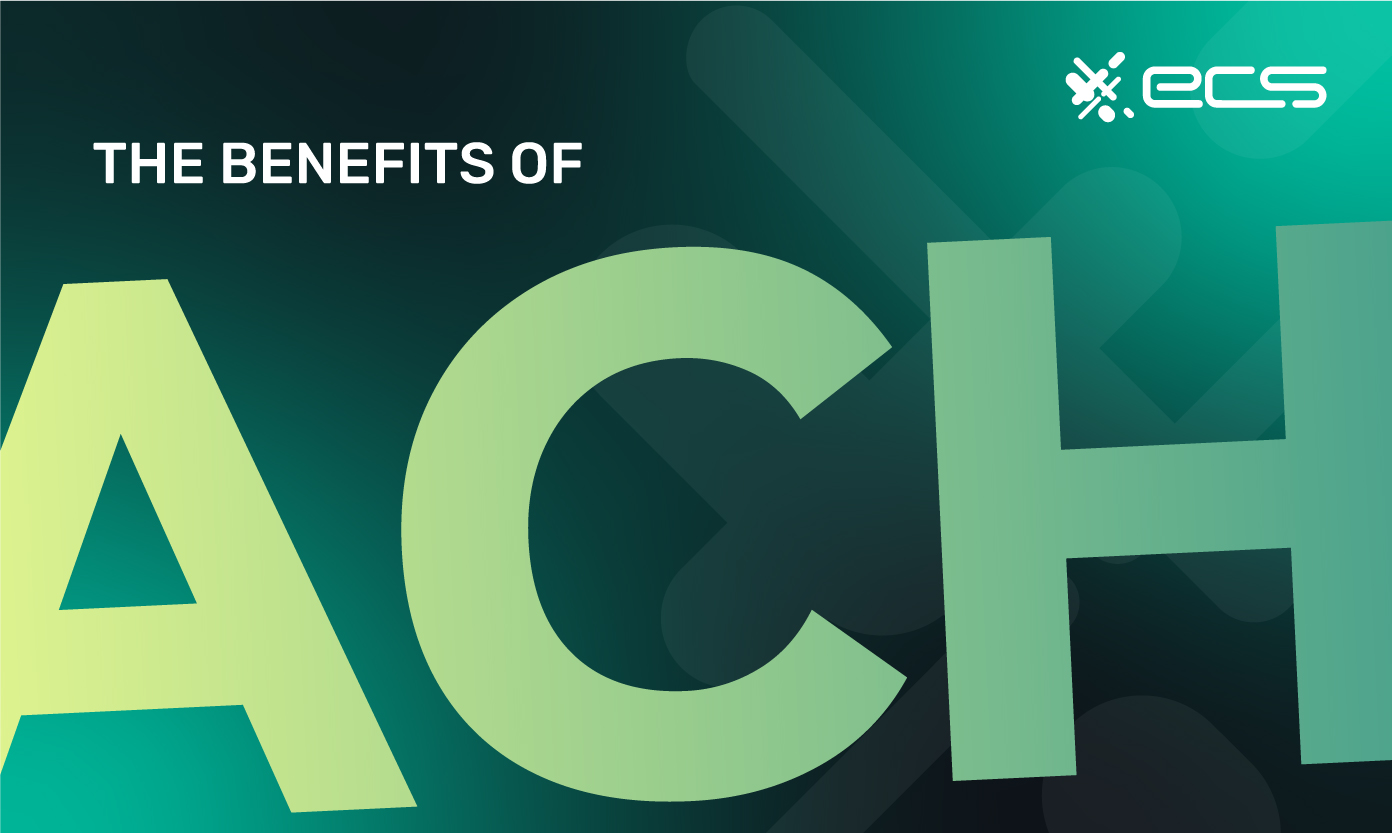ACH Payments transfer money directly from a customer bank account into your business checking account. This method of collecting payments requires no debit or credit cards. Generally speaking, consumers and business owners view credit and debit card payments as the most convenient. So that said, what are the advantages of ACH payments? In this article, we will review all the benefits of ACH payments that your business can take advantage of.
Are ACH Payments the Same as Checks?
No, they are not, although they operate on similar principles. It’s no secret that consumers do not like paper checks. Around 57% of consumers have not written a check in the past month. Many younger consumers do not use them at all, and around 60% of GenZ consumers do not even own a checkbook.
Consumers, especially younger consumers, have flocked toward contactless and mobile payments. The COVID-19 pandemic accelerated their usage and its attendant health and hygiene considerations. Another factor is the rise of P2P payment apps like Venmo or applications like Zelle.
This technology has made it easier for consumers to ditch their wallets entirely and not just their checkbooks. But this information leaves us with the same question: what are the benefits of ACH payments over checks, cash, and plastic cards? Why use ACH payments?
Benefit #1: ACH Payments Have Lower Costs
Every method of collecting payments has its costs—even cash. By contrast, one of the biggest benefits of ACH payments for vendors is their low cost. Let’s take a look at the different methods of receiving payments (cash, card, and checks as examples) and compare them to the cost of accepting ACH payments.
First, let’s look at cash. There are no fees for collecting cash payments, right? Indeed, at the point of sale, there are not. However, there are numerous hidden costs. One is the cost of bringing cash to the bank at the end of the business day. If you are not going to do this yourself, you’ll have to hire a company like Brinks to do it for you.
If you are going to take it to the bank yourself, that is going to take time. And time is money—especially at the end of the business day when you want to get home and crack open a few cold ones.
Another cost is the cost of cash-associated risks like counterfeit money. Cash businesses also tend to attract more criminality. In some locations with increasing crime, some businesses have even decided not to accept cash at all.
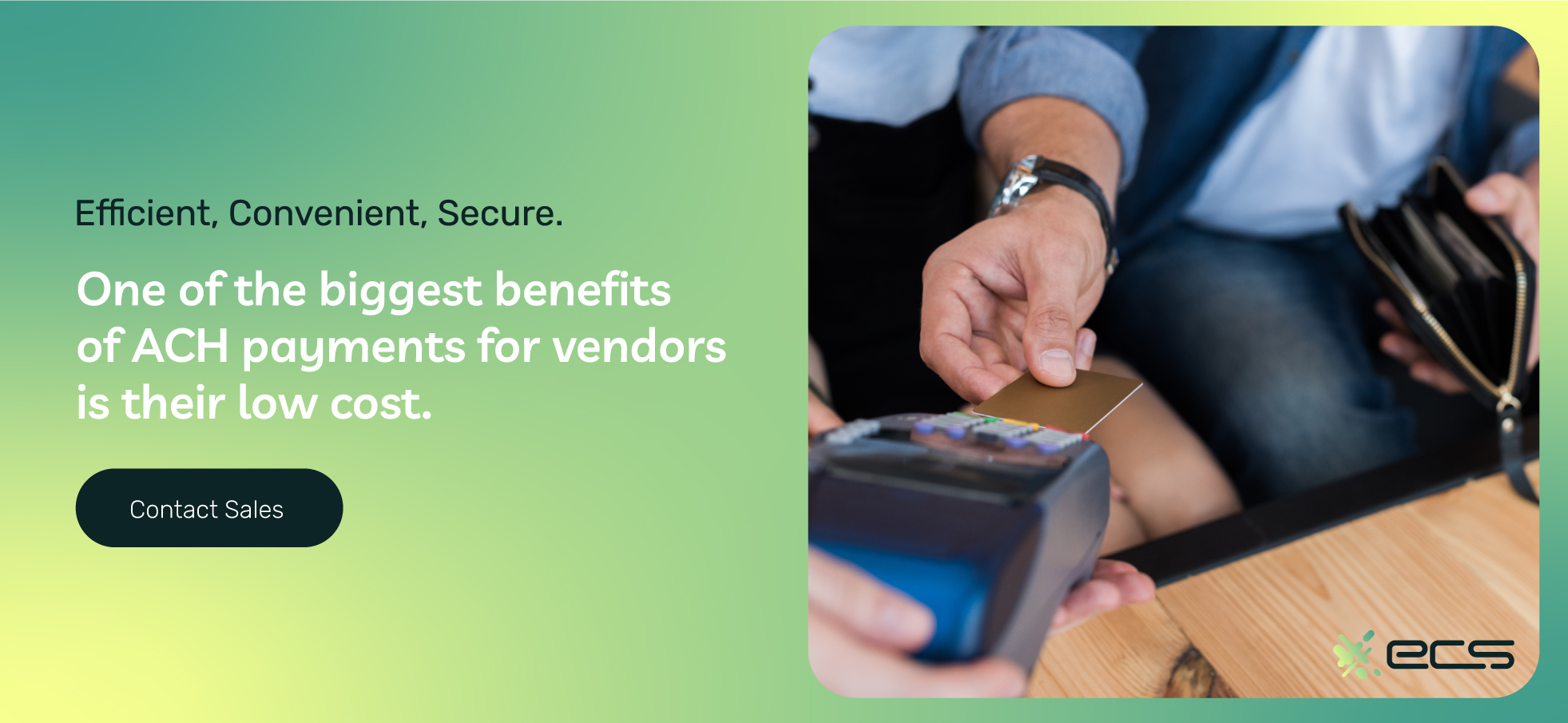
Plastic Payments and Their Fees
Now, on to credit and debit cards. These cards certainly have fees—numerous ones, at that. There are several financial institutions involved in clearing a plastic payment:
- The customer’s bank
- Their credit card issuer
- Your payment processor
- The card network
- Your own merchant bank
Each one of these parties needs to collect a fee to facilitate the transaction. The total of these fees is the merchant discount rate.
The merchant discount rate, or MDR, is often between 2% to 3%. This exact number depends on various factors, including the Merchant Category Code. The card network assigns this MCC to the business. It categorizes the business for accounting, regulatory, and customer-facing rewards purposes (e.g., credit card points).
Then there are pricing plans: fixed, tiered, and interchange-plus. Fixed pricing is exactly what it sounds like. This is the model used by large payment aggregators like Paypal, Stripe, and Square.
Tiered pricing sounds a little better, but it’s often set up to protect the bank from risk: the cards that customers would most likely want to use (rewards cards) or that would bring the biggest sales (business cards) have the biggest fees.
What about interchange-plus pricing? This is usually the best business model. But even so—based on other factors like the merchant category code—fees could run up to 4%. Codes with “riskier” goods or services can rack up higher fees, like jewelry (5094), charter jets (5192), legal services (8111), and dating services (7273).
The Cost of ACH Payments Compared to Plastic
Then, there is the type of card the customer uses in the transaction. There are four major card networks: Visa, Mastercard, Discover, and American Express. While the first three generally cost between 2% and 3%, there are times when American Express can get closer to 3.5%.
Some merchants (like those who no longer take cash) want to steer their customers towards using certain cards or avoiding others. But this can sometimes create a negative customer experience. Many business owners, for example, like using American Express cards because the rewards are generous and geared toward business travel.
But that leaves you in a bit of a pickle. Imagine having to pay 3.5% towards the glory of ancient Rome every time someone makes a purchase (we’re referring to the Amex Centurion logo). Or contributing 2.5% towards Mastercard’s blissful mantra and its mental wellness marketing: for everything else… there’s Mastercard. Inhale. Exhale. Swipe.
No, thank you. Or rather, yes, please—since plastic payments are the most cost-effective way to run a high volume of (especially low-cost) transactions. You may not feel the pain if your average ticket is under $50. But what if the average purchase is more? For instance, even 2% becomes burdensome if you sell big-ticket items.
ACH Versus Plastic Payments: An Example
Suppose you are selling something that costs $5,000. Mastercard’s rake in this example comes out to $100 or $125. This does not seem so bad, but after a fiscal year of collecting these kinds of payments, you may have lost thousands or tens of thousands of dollars to fees.
This is where ACH payments clearly beat cash, checks, and credit card payments. The average ACH payment costs about $0.29. Apply this to the example above, and the savings are evident. ACH payments may not make sense for small-ticket items. For instance, a $5 ACH payment might cost $0.29, compared to $0.10 for accepting plastic.
That said, ACH payments do not make much sense cost-wise for milk, bread, and eggs. However, they do make a lot more sense for larger ticket items. They also make sense for medium-sized tickets, especially recurring ones like a subscription or membership fee.
Benefit #2: ACH Payment Processing is Convenient
This brings us to our next selling point: convenience. ACH payments are particularly convenient for you, the merchant. That’s because you won’t have to take cash or checks to the bank. All you need to do is collect the customer’s bank account information and perhaps a few other details—like their account name and approval.
ACH payments involve transferring money from the customer’s account to yours (more on how they work later). As such, the information that moves the money is bank account and routing numbers. These numbers do not change, ever. By contrast, credit card and debit card numbers do change. They change if the customer loses their card or if someone steals it.
The bank also changes these numbers every few years for security purposes. All or any of these events can disrupt the continuity of collecting recurring customer payments. You will have to follow up with the customer to collect your payment. If these follow-ups are not automated, that will be additional time and/or money.
You might even lose the customer or subscriber. Moments like this create an opportunity for the customer to conduct their own cost-benefit analysis of the subscription. They may decide there is a better deal out there or that they no longer want to “Netflix and Chill,” as younger consumers might say.
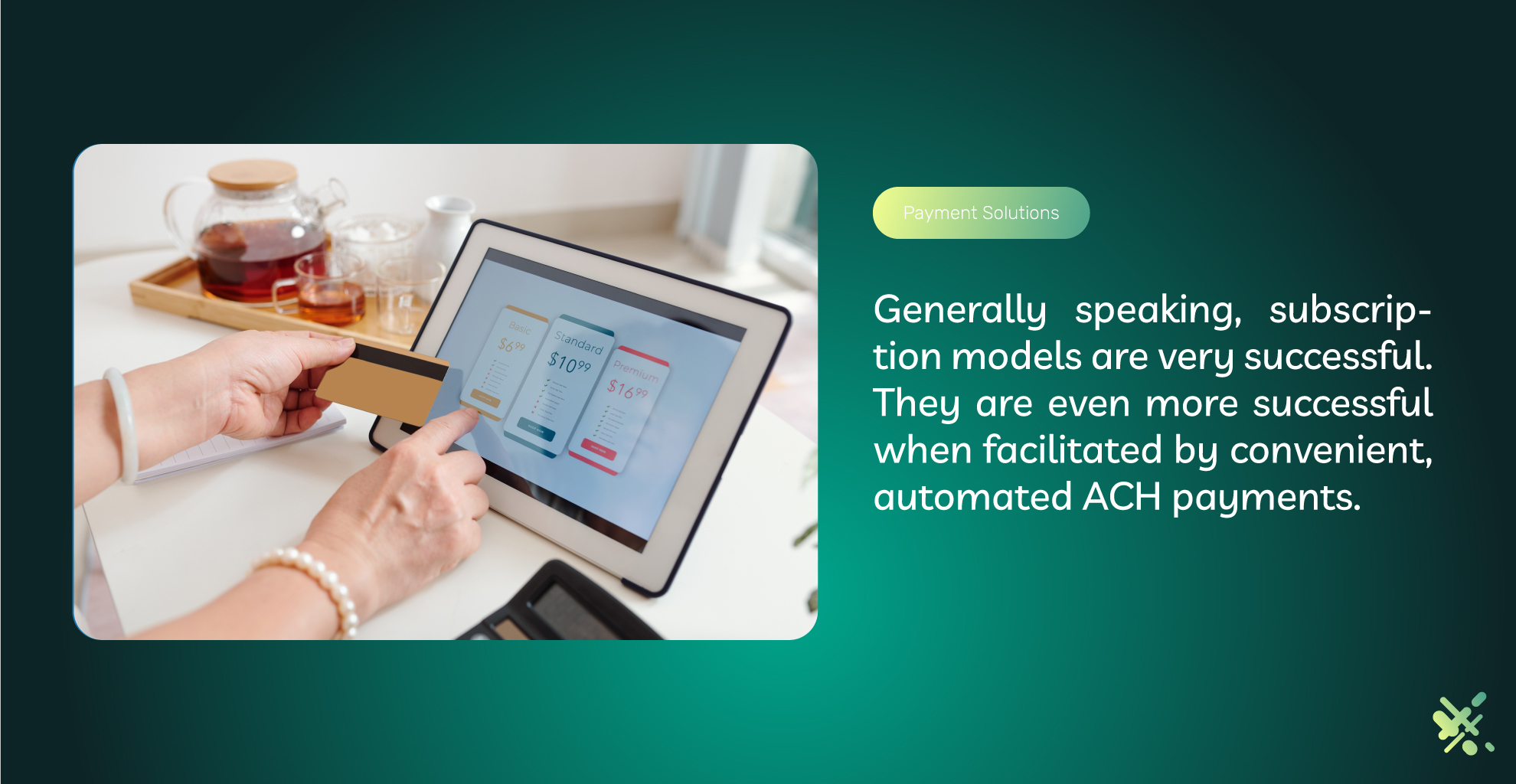
The Benefits of a Subscription Model
Generally speaking, subscription models are very successful. They are even more successful when facilitated by convenient, automated ACH payments. As mentioned, this is because banking information does not change. This removes at least one potential roadblock to collecting an uninterrupted, eternal flow of tribute to your imperial coffers.
Here are a few mouth-watering stats about subscription services: they have grown six times faster than the overall S&P 500 index. This is perhaps why 70% of businesses are looking into how to incorporate subscription services. American consumers are particularly fond of subscriptions, consuming 53% of the global market (Europe is behind at 21%, followed by Mainland China at 14%). The average monthly consumer spend on subscriptions is a whopping $273 per month—a 15% increase over the last three years.
Consumers tend to have multiple subscriptions, which shows their appreciation for the convenience they offer. The average American consumer actually has 12 subscriptions; millennials lead the way with 17 subscriptions each. Around 98% of consumers subscribe to some sort of streaming service, which is how most Americans consume their in-home entertainment these days—rest in peace, Blockbuster.
All of these stats show that subscriptions are an excellent business model. If you’re selling goods, you might wonder how subscriptions could work. In fact, physical products represent 45% of the subscription market value. These include everything from essentials like food and medicine to bespoke niche items.
Collecting ACH Details Has Never Been Easier
The best way to collect payments for a subscription service is to collect ACH details like the ABA and account numbers. This will preserve the continuity of payments by using permanent account numbers. It is also very easy for consumers to enroll in ACH withdrawals. While it might be cumbersome to pull out a check or log into a banking app to get banking info for an in-person purchase, it’s easy to do at home.
Moreover, there is an emerging market sector of fintech apps that connect their banking info to the payment processor. Companies like Plaid can help set up an ACH agreement with a few thumb taps. When prompted by Plaid, customers log into their online banking portal and receive a verification text from their bank.
Your payment processor may work with a company like Plaid or even have their own in-house solution for collecting ACH details. Gone are the days of customers having to hunt for a check and then decipher the robotic-looking numbers at the bottom. Instead, they can enroll in ACH payments from their phone or computer within seconds.
Benefit #3: Customers Like ACH Payments
Let’s continue discussing the benefits of ACH payments for customers. ACH payments allow consumers to put certain expenses on autopilot, making life easier (for them). The average American has a lot of bills to juggle: utilities, rent or mortgage, car loan payments, student loan payments, car insurance, home or renters insurance, credit card bills…this is in addition to all their variable expenses like gas and groceries.
Then, of course, there are the aforementioned subscriptions they spend on. The average millennial juggling 17 subscriptions (Netflix, Hulu, Disney+, Peloton, HelloFresh, AmazonPrime, and whatever else) does not want to manually make payments every month. They want these payments to be on autopilot.
Of course, this means that 89% of consumers underestimate their subscription spending. But even so, they far prefer this to making several dozen phone calls every month or logging into an online account to pay their bills.
Customers may also appreciate the aforementioned continuity of ACH payments. Remember that the replacement’s number will change if a customer loses their card. This will result in a disruption in payments, which in turn can bump them off their subscription.
They may not know this has occurred until they get in their car and can’t locate their favorite niche station on satellite radio. Or, it may occur when they file a car insurance claim and there is a lapse in coverage.
True, large businesses have an automated process for sending out mail, texting, calling, and emailing customers who have fallen behind on their payments, but consumers can still miss these notifications.
In case of a stolen credit or debit card, banks advise cardholders to contact their recurring billers to provide them with updated payment information. But a consumer may forget to do this. Or, after they’ve updated their billing info with their mortgage lender and utility company, they may forget to update the details with your subscription.
This is where it’s good to have a payment processor that integrates with other software suites, like automated customer reminders. Or, even better, it’s good to set up automated recurring payments as ACH payments. That way, there will never be the need to recapture payment info. Most customers do not mind inputting banking details at home, especially as it becomes easier with the increase in fintech applications.
In fact, it may even involve fewer steps than grabbing a credit card from their wallet..especially if they’re one of those consumers who look all over the house for their wallet, only to find it in their back pocket.
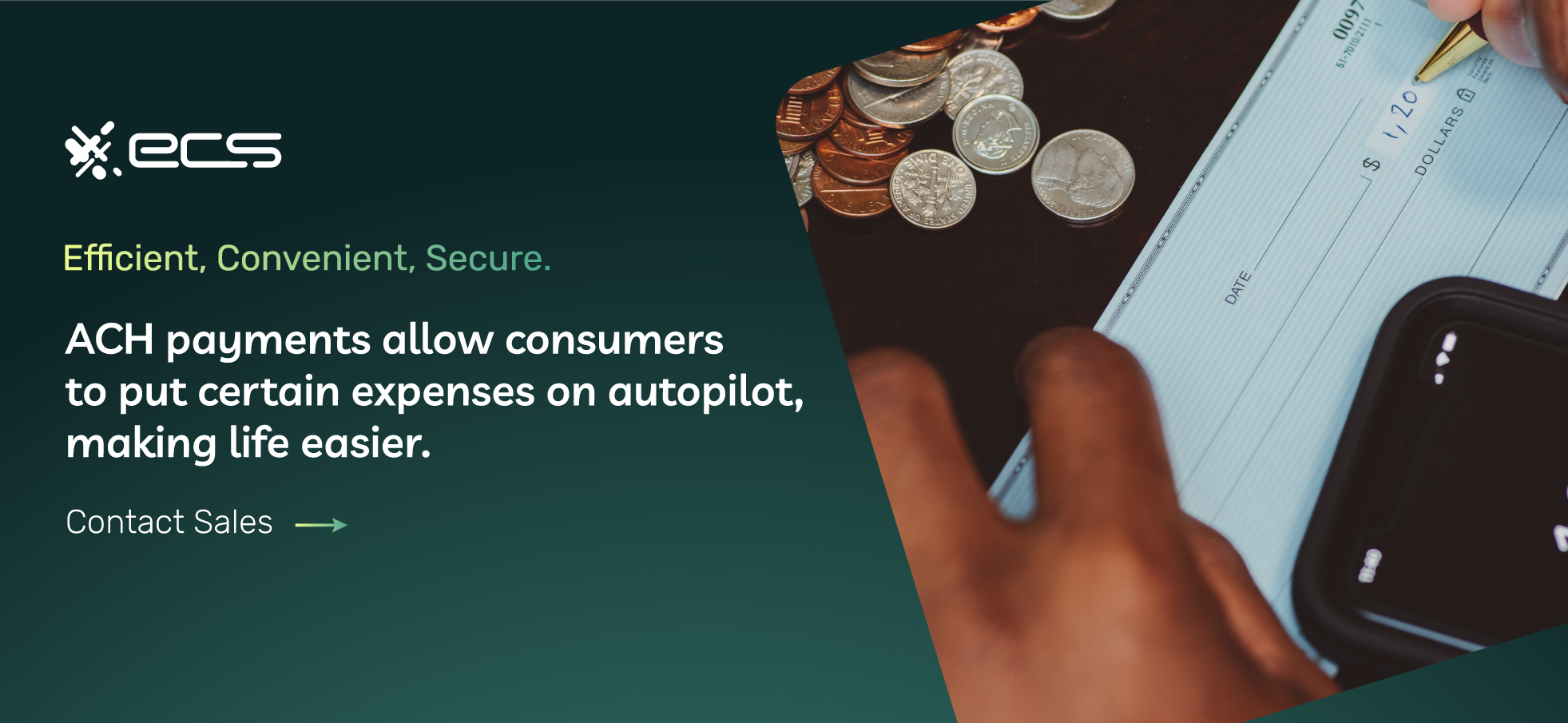
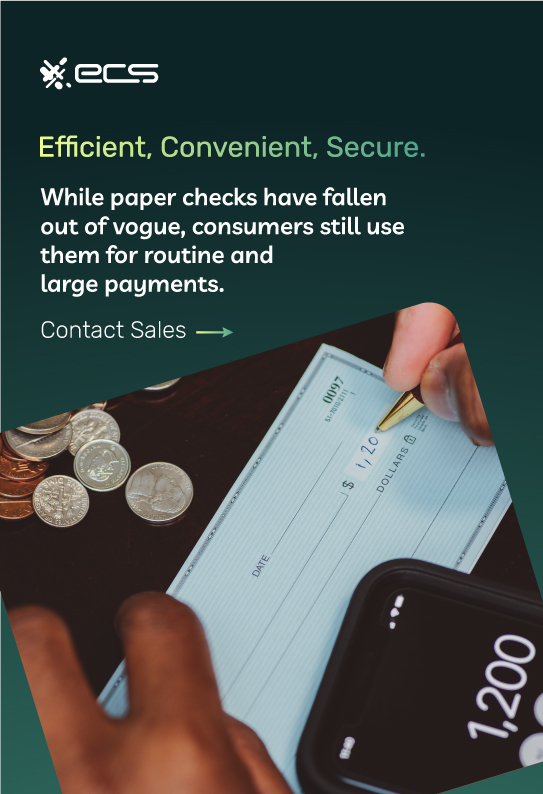
Check Usage Versus ACH For Larger and/or Recurring Bills
Check usage has significantly declined over the last two decades. For instance, while 40 billion check payments were made in 2000, just 20 million were made in 2018. By contrast, ACH payments grew 6% from 2015 to 2018. They saw record growth in 2020, with 2 billion new payments processed.
While paper checks have fallen out of vogue, consumers still use them for routine and large payments. There are several reasons for this, but one reason is that many of these billers pass on credit card fees to their customers. For instance, a utility company might tell consumers that credit card payments will be subject to a 3% convenience fee (this is legal in most states, as long as the business posts this information).
Customers do not want to pay these fees. But they also do not want to fill out a paper check and send it in the mail. The growth rate of these ACH transactions, especially when contrasted with paper checks, shows a viable solution compared to plastic payments. The ACH payment costs them nothing; they can conveniently do it from home.
Benefit #4: ACH Payments Are Secure
Another benefit to ACH payments is their security. To clarify, there are layers of security around credit card payments, especially with the advent of contactless payments and EMV chips over magnetic strips. However, online payments (card not present or CNP transactions) are still woefully subject to fraud. If a thief actually gets a hold of a wallet with a driver’s license and a credit card, they can easily use that information to start making purchases online.
Even if they don’t have all the pieces, technology is increasingly facilitating the ability of cybercriminals to commit Frankenstein theft. This involves piecing together information about a customer purchased from the dark web or scoured from Facebook.
One could even say that ACH payments are safer than credit card payments. This is in part because ACH payments are not entirely automated. Operators sent them out in batches throughout the business day. In addition to these operators, banks and payment processors have developed tools for monitoring and flagging fraudulent situations.
To boil it down, some of these tools involve using AI to analyze customer purchase patterns. AI may flag and stop the payment if a purchase falls outside the scope of what they usually purchase, the amount they spend, and the vendor’s location. Your payment processor should be up to date on these kinds of measures, using the latest tools.
Lastly, ACH payments are much more secure than traditional paper checks. ACH is not a check, although the network uses the same information for the transaction, such as bank account and routing numbers. Therefore, ACH is also an eCheck or electronic check.
Checks are a single piece of paper handled by a bank teller or banker. Checks can be stolen, intercepted, and lost. Several things could go wrong along the way. If you don’t believe it, watch the movie Blank Check with Brian Bonsall and Karen Duffy.
What Do You Need for ACH Payments?
Now, on to the question you’ve probably been asking this whole time: how do ACH payments work? ACH stands for the Automated Clearing House Network. A clearinghouse is a financial institution that temporarily holds money as it passes from one party to another. In the ACH system, that clearinghouse is often one regional branch of the Federal Reserve Bank of the United States.
On the ground level, here is how ACH payments work. The business collects account and routing info from the customer, along with their name and approval, to process ACH transactions. If there will be multiple transactions, the agreement must specify the amount in question and on what day of the month it will occur.
Some merchant banks conduct ACH services. However, an ACH payment processor may be significantly lower in cost. Additionally, the payment processor will also help you collect debit and credit payments, bundling it all into a fee structure that works better for you. Either way, you need a business banking account to facilitate ACH credits and debits.
Once the payment details are collected, they are passed on to ACH operators. These operators are part of NACHA or the National Automated Clearinghouse Association. NACHA is not a government entity. Rather, it is a coalition of tens of thousands of banks, financial institutions, and businesses that use ACH payments to issue employee payroll.
ACH payments are sent out in batches throughout the business day. This means Monday through Friday, excluding bank holidays (like Thanksgiving, Christmas, and July 4th). ACH payments have historically taken 24-48 hours to settle, which is about the same time as a credit card payment. However, same-day ACH payments are increasingly accessible.
Benefits of ACH Payment Wrap-Up
Low-cost ACH payments are economical, convenient, and secure, and customers like them. You’ll find that ACH payments are probably the best way to go for large purchases and recurring billing. To learn more about the benefits of ACH payments and accepting them at your business, give us a call or fill out the contact form below.
The Automated Clearing House Network facilitates ACH payment or the transfer of funds from a customer’s bank account to a business’s account using account and routing numbers.
Unlike paper checks, ACH payments are completely digital. Checks are becoming less popular due to the rise of simple electronic payment methods, making ACH payments a more convenient and efficient alternative. ECS Payments is here to help your business set up ACH processing.
The biggest advantage of ACH payments is their cost-effectiveness. Credit cards will have much higher processing fees and often require more equipment to process payments. Cash takes time to deposit into the bank or takes additional funds to have a security team pick up. Either way, cash is less secure and more costly than ACH. ACH payments have a low fixed fee per transaction, which makes them especially ideal for large purchases and recurring billing. ECS Payments offers ACH payment processing services that help businesses reduce their transaction costs and manage their payments more efficiently. Contact us today to implement ACH into your payment solutions.
ACH payments are convenient for customers because they can set certain payments on autopilot, making it easier to manage their bills and subscriptions. Automatic and recurring payments eliminate disruptions in services and provide businesses with continuous funds for their services with far less manual effort. ECS Payments can help businesses set up automated ACH payments for a more convenient and reliable payment experience.
